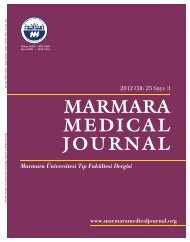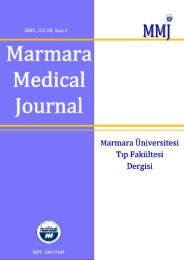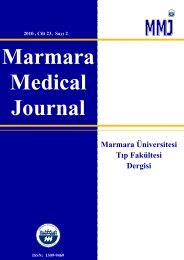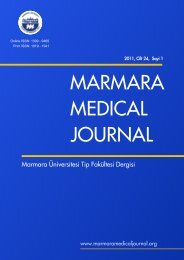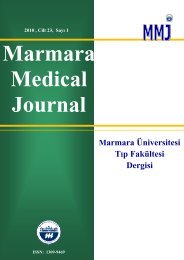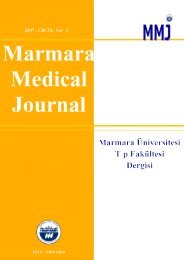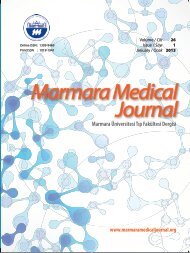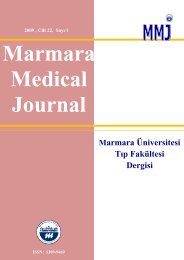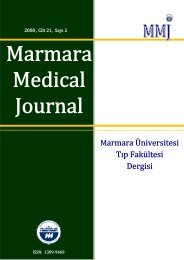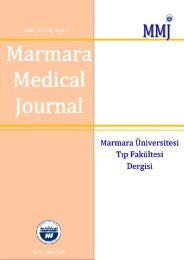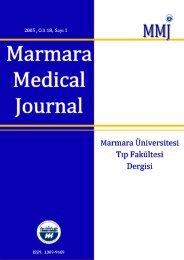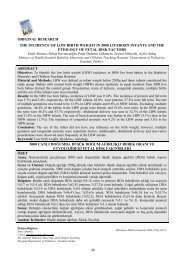Tam Metin PDF (4158 KB) - Marmara Medical Journal
Tam Metin PDF (4158 KB) - Marmara Medical Journal
Tam Metin PDF (4158 KB) - Marmara Medical Journal
- No tags were found...
You also want an ePaper? Increase the reach of your titles
YUMPU automatically turns print PDFs into web optimized ePapers that Google loves.
V. M. SANTOS, et alPhoto-quizANSWER to PHOTO-QUIZVenous ulcer of lower limb (Stasis ulcer)Skin ulcers are common, with variableaspect and diverse etiologies including: venous(stasis) and arterial insufficiency, neuropathy,malignancy, metabolic disturbance, trauma,hematological disorder, and infectious or parasiticagents. Chronic venous insufficiency is oftenassociated with leg stasis ulcer 1-4 Suspicion ofvascular ulcers is based on anamnesis and physicalexamination (site, borders, depth, size and adjacentchanges). Such ulcers may be recurrent andpersistent, because improvement depends onsystemic (age, nutritional state and immunity) andlocal (blood circulation and infection) factors.Complications like cellulites, osteomyelitis,malignancy, bacteriemia and sepsis may occur 1,5Treatment of stasis ulcer includes pentoxifylline,aspirin, antibiotics, compression, local care, anddebridement 1-5 .Ulcers of lower limbs are common findings,and can cause pain and functional limitation. Stasisulcers are characteristically shallow and irregular,prevailing over bone prominences; nevertheless, thedifferential diagnosis may constitute a challenge forprimary care workers. Most of the ulcers in lowerlimbs are associated with venous or arterialinsufficiency and diabetes mellitus; however, lessfrequent etiologies, as infectious diseases must beconsidered. The management of leg ulcers inprimary care attention is often based solely onclinical data. In this case study, the stasis ulcerappeared associated with chronic venousinsufficiency and previous saphenectomy.Notwithstanding, cutaneous leishmaniasis was aninitial major concern because the lesion appearedon exposed area after an insect bite, evolving aspapule followed by an ulcer 6,7 . Recent studies on thetransmission of leishmaniasis in Brasília-DFoutskirts confirmed autochthonous human visceraldisease, and detected Lutzomyia whitmani andLeishmania (Viannia) braziliensis in domestic andperidomestic areas 8,9 . However, the lesion appearedsoon after the insect bite as pruriginous papuletopped with vesicle, that was excoriated byscratching. The resultant ulcer was painful, withoutraised heaped up margins or granuloma at its base.Moreover, direct examination, cultures, and skinbiopsy did not reveal pathogenic agents, andMontenegro's test was negative. Although she wasafro-descendent and had arterial hypertension, thehypotheses of arterial insufficiency and sickle-cellanemia were ruled out by arterial evaluation andhemoglobin electrophoresis. Furthermore, thediagnosis of venous ulcer was established byclinical data and echo-Doppler findings. Successfultreatment included analgesics, lower limb elevation,compression and local care. Case studies cancontribute to highlight the role of efforts aimingprevention of venous ulcer 2 . Leishmaniosis shouldbe included in differential diagnosis of cutaneouslesions in patients from large urban conglomerates,where domestic/ peridomestic infection can bedocumented.REFERENCES1. Collins L, Seraj S. Diagnosis and treatment ofvenous ulcers. Am Fam Physician 2010;81:989-996.2. Passman MA; Writing Group IV of the PacificVascular Symposium 6, Elias S, Dalsing M, et al.Non-medical initiatives to decrease venousulcers prevalence. J Vasc Surg 2010;5:29S-36S.doi:10.1016/j.jvs.2010.05.0713. Briggs M, Nelson EA. Topical agents ordressings for pain in venous leg ulcers.Cochrane Database Syst Rev 2010 Apr14;4:CD001177.doi:10.1002/14651858.CD001177.pub24. Kistner RL, Shafritz R, Stark KR, Warriner RA3rd. Emerging treatment options for venousulceration in today’s wound care practice.Ostomy Wound Manage 2010;56:E1-11.5. O’Meara S, Al-Kurdi D, Ologun Y, Ovington LG.Antibiotics and antiseptics for venous leg ulcers.Cochrane Database Syst Rev 2010 Jan20;1:CD003557.doi:10.1002/14651858.CD003557.pub26. Ozaras R, Polat E, Aygun G, et al. A family withskin lesions. Neth J Med 2010;68:41-44.7. Toz SO, Nasereddin A, Ozbel Y, et al.Leishmaniasis in Turkey: molecularcharacterization of Leishmania from human andcanine clinical samples. Trop Med Int Health2009;14:1401-1406. doi/10.1111/j.1365-3156.2009.02384.x8. Carranza-<strong>Tam</strong>ayo CO, Carvalho MSL, Bredt A,et al. Autochthonous visceral leishmaniasis inBrasília, Federal District, Brazil. Rev Soc BrasMed Trop 2010;43:396-399.9. Sampaio RN, Gonçalves Mde C, Leite VA, et al.[Study on the transmission of Americancutaneous leishmaniasis in the Federal District].Rev Soc Bras Med Trop 2009;42:686-690. doi:10.1590/S0037-8682200900060001582<strong>Marmara</strong> <strong>Medical</strong> <strong>Journal</strong> 2011; 24 (1):81-82



